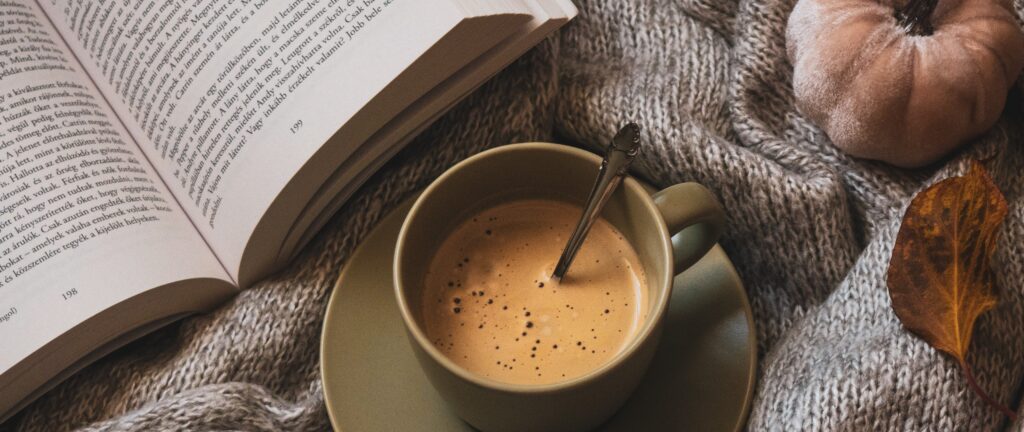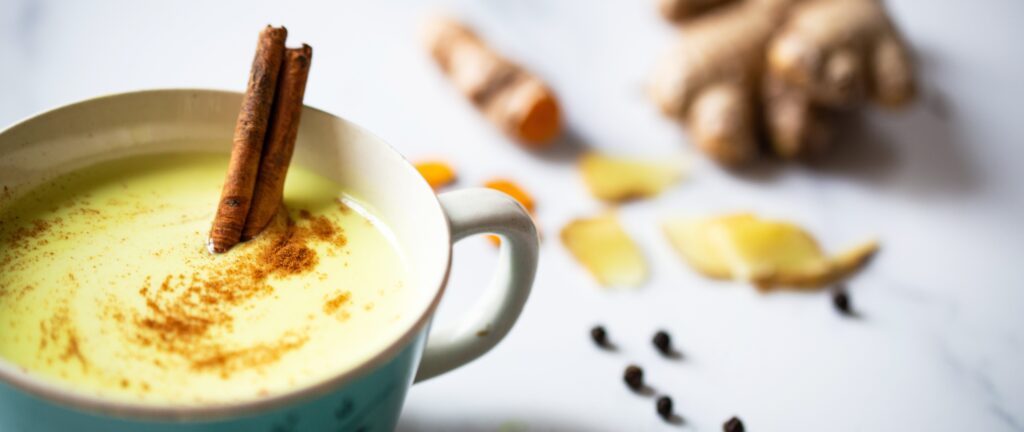Caffeine and Wellness: Finding Balance for Productive Days and Restful Nights
We hope you’re soaking up all the Fall vibes! Here in our neck of the woods, the leaves are putting on their autumn show, and it’s dark when our alarm lets us know it’s time to start the day. On November 5, 2023, we fall back with our clocks once again, which will give us a sliver of daylight in the mornings, but our evenings will arrive that much sooner. This often cues us to cozy down, and we may find our focus shifting more inward.

Yet, our modern lives continue as though nothing is happening. Thanks to artificial lighting and 24/7 communication access through our devices, our bodies can lose their sense of connection to these natural cycles. And there’s one time-honored solution to helping us power through the slower, sleepier seasons—caffeine.
We’ve talked about caffeine before, and its connection to cortisol, often called our “stress hormone.” It’s so tempting and easy to reach for that extra boost of oomph, especially when it tastes so good and feels so comforting. And if you’re having trouble sleeping, this is definitely something you need to learn about. So we thought we’d review a few best practices for caffeine, and offer some alternatives if you’re feeling a bit frazzled and jittery. Let’s get into it!

The Good
Let’s be honest…we love caffeine. And luckily, if you’re someone who’s able to tolerate caffeine, it loves you too. Some of the benefits of caffeine include:
- Protection against neurodegenerative diseases like Alzheimer’s and Parkinson’s
- Improved focus, alertness, and mood
- Headache relief
- Increased strength outputs and oxygen intake during workouts and physical activity
Caffeine can really help on-ramp our day, and it provides a productive boost for all sorts of mental tasks, from leading meetings at work to taking tests at school. For many coffee and tea drinkers, it’s a treasured daily ritual and an opportunity for contemplation or socializing.

The Bad
Well, some people just don’t have a great time with caffeine, and some former caffeine users have discovered that life without it is so much better. Barring that, most ill effects can be chalked up to user error. That’s right—there’s a wrong way to caffeine. Caffeine is a great example of how more does not equal better.
Some things to know:
- Aging. Our ability to metabolize caffeine may change as we go through the years. Many people find that they need to reduce their overall caffeine intake due to jitteriness. What once worked for us may suddenly not one day, so we need to adapt our approach, our choice of beverages, or the amount we’re consuming.
- The Body’s Response. Many issues can pop up, particularly with coffee drinking—acid reflux and jitters are common complaints. This can be for a multitude of reasons, but if your body is giving you signs of not being that into your favorite drink anymore, you may need to adjust the amount or the quality (aim higher). It’s also extremely helpful to wait until after you’ve eaten something. If you’re mold sensitive, coffee can exacerbate that.
- Genetics. Not everyone responds to caffeine in the same way. Genetics plays a part in this, and if you’re curious, you can identify that with popular genetic testing sites like 23andMe.
- Other Side Effects. Too much caffeine can cause all sorts of trouble, including headaches, insomnia, nervousness, restlessness, nausea, increased heart rate, and even chest pains.
Luckily, research and lots of experimentation has given us a roadmap for smart caffeine usage. With a bit of know-how, you can rescue your favorite routine beverage and consciously continue drinking it.
Caffeine Best Practices
Here it is, folks! The caffeine master plan.
- Calculate your dosage. 1-3 milligrams of caffeine per kilogram of body weight. So for someone who weighs 150 pounds, this would equal an intake from 68-204 milligrams. For reference:
- a 12-ounce soda = 30-40mg
- an 8-ounce cup of green or black tea = 30-50mg (Note that matcha can vary wildly between 38-176mg of caffeine per serving)
- an 8-ounce cup of coffee = 80-100mg
- and each shot of espresso = 65mg
- First sip 90-120 minutes after waking and eating. This allows your brain to naturally clear out the adenosine that takes time to dissipate after waking. Caffeine blocks this process, which leads to afternoon sleepiness. Eating something first cushions the blow to your digestive system and helps prevent the jitters. Pro tip: Exercise and viewing morning sunlight helps clear out adenosine as well.
- Skip the afternoon refill. Depending on individual tolerance, caffeine can take up to 8-12 hours to fully clear from your system. If insomnia or sleep troubles are an issue, take this into consideration. And if you practice the above bullet point, you may find you don’t need the afternoon bump after all.
- Notice if change is needed. Many people report needing to reduce their caffeine intake as they get older. It’s also not a great idea to drink too much of it when you’re in a prolonged stressful period of life. Consider cutting full-caff coffee by half with decaf coffee or another coffee alternative (see below). Try going from coffee to tea, which is much gentler on your system. If your morning beverage is a major source of sugar or artificial additives in your life, begin the switch to more natural options. If you decide to quit caffeine altogether, you may want to taper off rather than going cold turkey—caffeine withdrawals are no fun and include headaches, fatigue, drowsiness and irritability.

Caffeine Alternatives & Nightcaps
Sometimes it’s just time to try something new. Whether your body is giving you a sign or you’re just not loving being addicted to something every morning, there are plenty of alternatives out there. These can also be used for cutting your full-caff coffee.
- The Fullest’s Warm Feelings Saffron Latte. Simple, well-sourced ingredients combine into a creamy, dreamy beverage. Saffron is a surprising addition you don’t see every day, and it’s got serious mood-boosting, anti-inflammatory benefits. Also great at night. If you happen to be local to our showroom in Ashland, OR, stop by for your jar—we’re carrying this one in-house!
- Rasa Coffee Alternatives. From medicinal mushrooms to adaptogenic herbs for caffeine-free energy, Rasa has a little bit of everything. For those just looking to reduce their caffeine amounts, they offer half-caff Dirty Rasa and Café Rasa smoothed out with herbs and mushrooms.
- Hot Cocoa/Cacao. Did you know that chocolate has a smidge of caffeine? 5mg per serving. If you go this route, be sure to source high quality, all-natural formulations, and keep the sweetener on the reasonable side. If you have trouble sleeping, maybe rethink the hot cocoa at night.
And just as we are habituated to a beverage to launch us into our morning, we can apply the same logic to winding down at the end of our day. Try these as part of your bedtime routine.
- Golden Milk. Healthy fats, anti-inflammatory turmeric, and warm, soothing cinnamon? Sign me up! Check out this recipe.
- Rasa Calm. A delicious toasty tonic to lull you to dreamland. Rasa’s bedtime option is chock full of herbs to relax and chill you out.
- Magic Melatonin Mocktail. Don’t forget our very own mocktail recipe! Tart cherry juice, honey, and rosemary all conspire to sing you to sleep.
- Herbal Teas. Tried and true. Look for sleepytime helpers like chamomile, valerian, lavender, and passionflower. Magnolia tea has a great reputation in traditional medicine.
Thanks for joining us on this adventure in responsible caffeine usage! If you’d like to learn more, we’ve got some great content on our Counting Sheep blog:
- Our Healthy Sleep Series on caffeine has more where this came from.
- Another Healthy Sleep Series on cortisol can help you understand the connection between caffeine and our stress hormone.
- For folks experiencing persistent fatigue, here are some common culprits to think about.
Be sure to follow us on Instagram and Pinterest for more healthy living and sleep tips. And until next time, sweet dreams!
THIS ARTICLE DOES NOT PROVIDE MEDICAL ADVICE
The information in this article, including but not limited to text, graphics, images, and other materials, are for informational and educational purposes only. No material here is intended as a substitute for professional medical advice, diagnosis, or treatment. Please consult your physician or other qualified health care practitioner with any questions or concerns you may have for your care.

